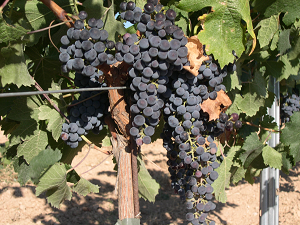 Merlot, that poor little blackbird (how apropos a name) that can't get a break since the movie Sideways.
Merlot, that poor little blackbird (how apropos a name) that can't get a break since the movie Sideways.
Viticulture
Features: moderately vigorous; large bunches of thin skinned grapes; ripens and buds early
Susceptibility: grey rot, coulure, downy mildew
Climate: cool to moderate
Soil: Damp, cool, clay-ey
Slows ripening in warm weather
Once ripe, it is important to pick quickly and avoid over-ripeness
Viniculture
Vinification:
Warm fermentation extracts lots of color, aroma, flavor and tannin
Malolactic Fermentation softens sharp malic acids and rounds out wine
Aging and Blending:
Oak aging natural partner to new oak, brings out the vanilla aromatics
Bordeaux or Meritage blend: partners with more highly structured Cabernet Sauvignon.
| Old World | New World |
|
France: Most commonly planted red grape Italy
|
California Chile |
Color: Garnet, aged wines get brickish toward rim
Aroma: Black and red fruit (plums and berries), cocoa, chocolate or baking spices; herbaceous in Bordeaux; Can develop tobacco, leather and dried fruit notes
Body: Medium, plush texture
Acid: Medium
Alcohol: Medium to high
Tannins: Medium, velvety
Flavors: Blueberry, plum, black currant, black cherry, mint, coffee, chocolate, violet, bell pepper, fruitcake